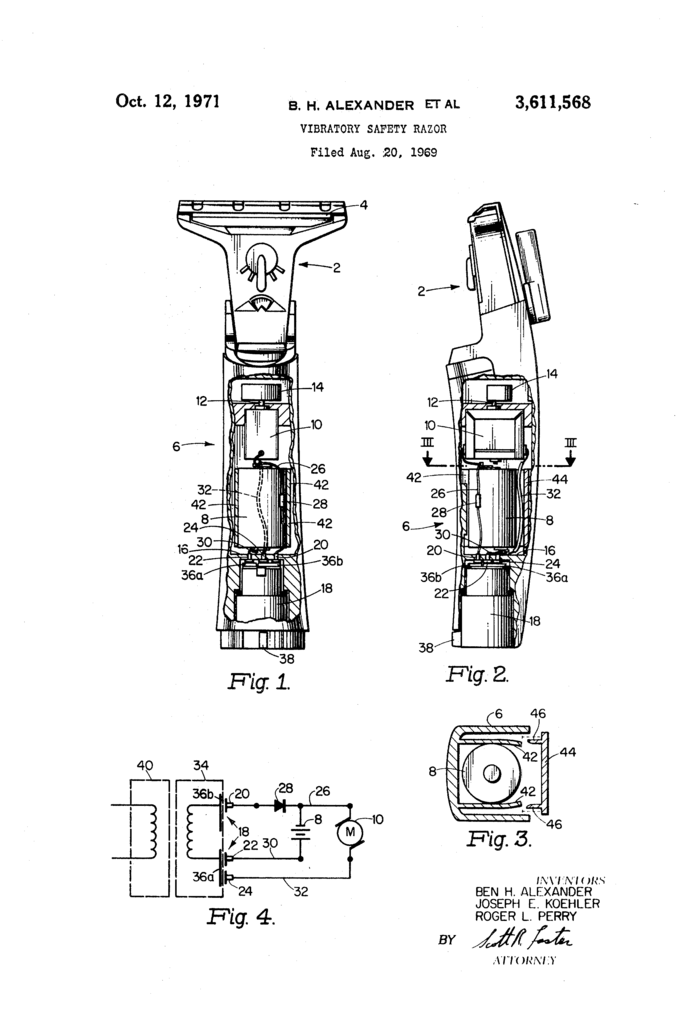While I don’t see the appeal – or the point – of a vibrating razor, patents for razors that shake, rattle and roll have been applied for multiple times1 over the last century – the idea keeps popping up like a weed in your lawn. Lately it seems to have taken root among cartridge razors, but the current crop is far from Gillette’s first attempt to bring some buzz into the bathroom.
Band razors – where the ‘blade’ is a thin band of steel that has an edge rolled from one spool to another like an audio cassette – is another idea that has popped up time and time again. They seems to have had a brief moment of popularity in the 30’s (Waine Rollband, Reel Watch Razor and Razor Six to mention a few that were for sale) and another flare up in the 60’s (Warner-Hudnut Reelshav, Gillette Techmatic and Schick Autoband were introduced then). The Techmatic – Gillette’s entry into the band razor craze of the late sixties – is often considered to be one of the worst razors offered for sale, likely due to inaccuracies and spotty quality control in manufacture of the replaceable cartridges.
So what do you get when you combine two ideas that simply wont die? US patent 3,611,568… that is what you get. Invented by Ben H Alexander, Joseph E Koehler, and Roger L Perry and assigned to Gillette Co LLC, the patents combines the head of an adjustable Techmatic band razor with a vibrating handle.
…the present invention is the provision of a safety razor comprising a head portion having cutting means mounted therein, and a handle portion having an electric motor mounted therein. A rotatable shaft is connected to the motor and extends therefrom. A weight is eccentrically mounted on the free end of the shaft and rotatable by the shaft, the weight being disposed proximate to the head portion of the razor, whereby upon rotation of the shaft and weight, the head portion is caused to vibrate and effect a slicing motion of the cutting means.
US patent 3,611,568

There is nothing that stands out as odd about the head – it is in fact barely mentioned in the patent, although the drawing makes it clear it’s the head of a adjustable Techmatic – but what makes this patent stand out to me is the fact that this is the earliest patent for a vibrating razor I’ve found so far that is powered by a battery and not by the 110VAC or – even better – 230VAC you get from the electrical outlet. So even if the shave don’t benefit from the shake, rattle and roll caused by the vibration, you’re much less likely to electrocute yourself as you mess around with sharp blades, lather and water.
The vibration bit is just an eccentrically mounted weight on the shaft of a small electric motor, but the power circuit is a lot more interesting. Figure 4 on the drawing and the patent text makes it quite clear that this was – for the time, and if y’all excuse the pun – cutting edge technology:
Also disposed in the handle portion 6 but separated from the battery 8 by a wall 16 is a switch means 18. In the Wall 16 are mounted three electrically conductive eyelets 20, 22, and 24. An electrical lead 26 connects the eyelet 20 with the battery 8 and the motor 10. The lead 26 includes a diode 28 which prevents reverse current flow through the switch. An electrical lead 30 connects the eyelet 22 with the battery 8. An electrical lead 32 connects the eyelet 24 with the motor 10.
US patent 3,611,568
The switch 18 includes a secondary coil 34 (FIG. 4) which is connected to a pair of contact plates 36a, 36b (FIGS. 1, 2, and 4). The switch 18 is mounted for rotative motion and may be rotated by movement of a tab 38, as by a thumb or finger of an operator. Rotation of the switch 18 causes movement of the contact 36a relative to the eyelets 22 and 24, the contact 36 maintaining engagement with the eyelet 20.
A primary coil 40 (FIG. 4) may be disposed in a base or stand member (not shown) for the purpose of inducting a current in the secondary coil…
So a rechargeable, battery operated, vibrating Techmatic, that would recharge every time you put it down in the base with the help of an inductive coil… not bad for 1969. I suspect the real downfall of the invention would be the battery, since affordable rechargeable batteries that could handle a large number of charge-discharge cycles were not available2 at the time. I have found no indication this was put into serious production, but according to Waits’ Razor Compendium a very similar it was test marketed as the Gillette Techmatic Sure Touch Shaver3 in 1971 – main difference from the patent is the location of the switch – but without too much fanfare. Gillette’s next vibrating razor offered for sale was the M3Power in 2004, which had a much better reception among the unwashed masses – probably because it (and it’s descendants and copy-cat razors) ran of ordinary batteries.
(1) For example, see “Stahly Live Blade Wind-up Vibrating Safety Razor“, “A possible shocking shave“, “Appliance for vibrating a safety razor” and several others I’ve written about in the past among other oddities.
(2) Most likely the inventors planned to use a NiCd battery (1.2V per cell – and the drawing shows 2 cells), with the NiFe battery (also 1.2V per cell) as another option. The former has decent discharge rates, but will only last about 2000 cycles – or about five and a half year if you shave daily – while the later can withstand almost unlimited charging cycles but have very low energy density.
(3) A name seemingly also used for other, non-vibrating Techmatics.

Pingback: The most adaptable of all razors - Wegian WetshavingWegian Wetshaving